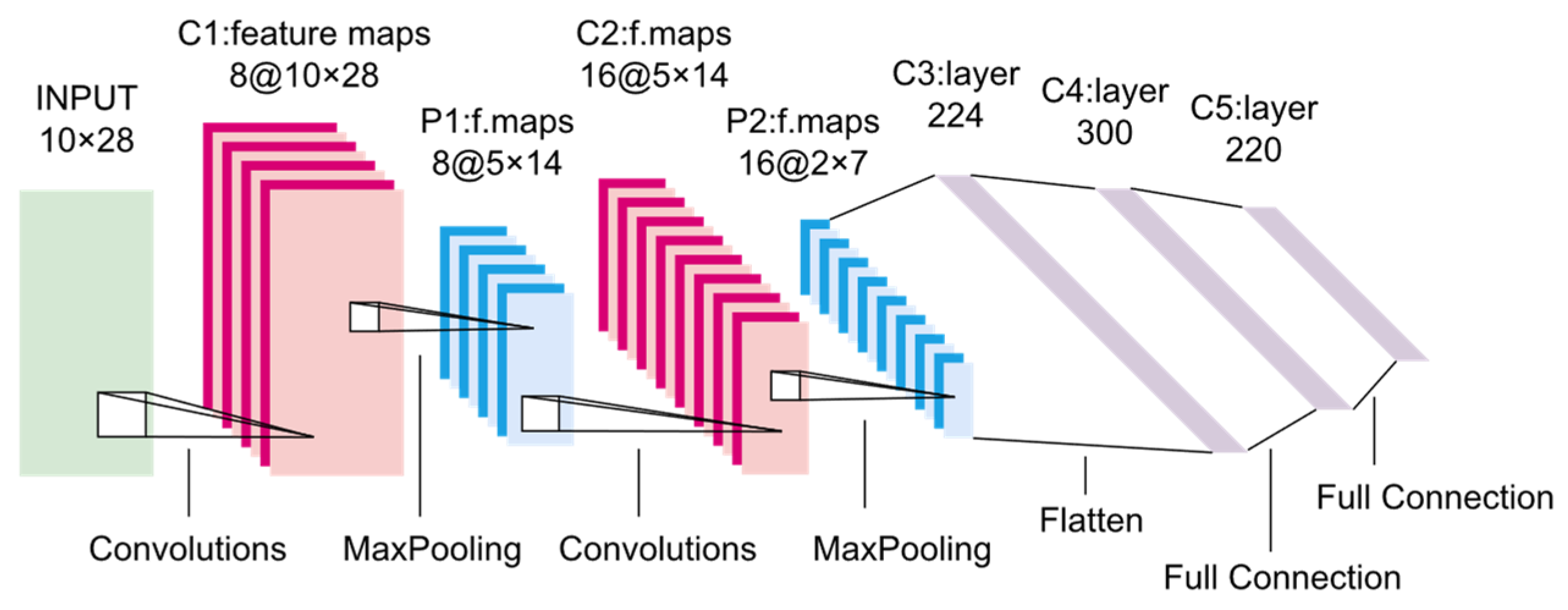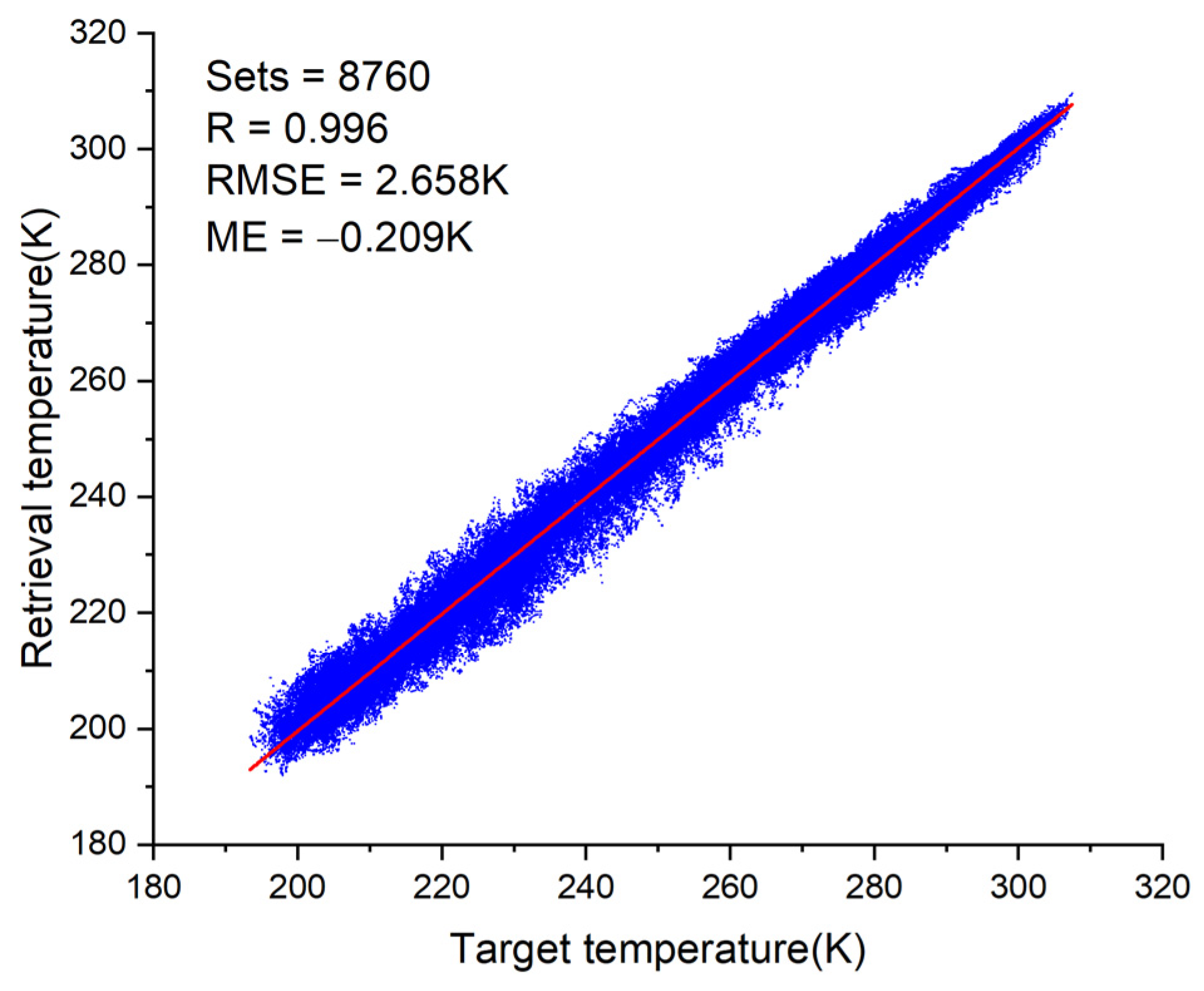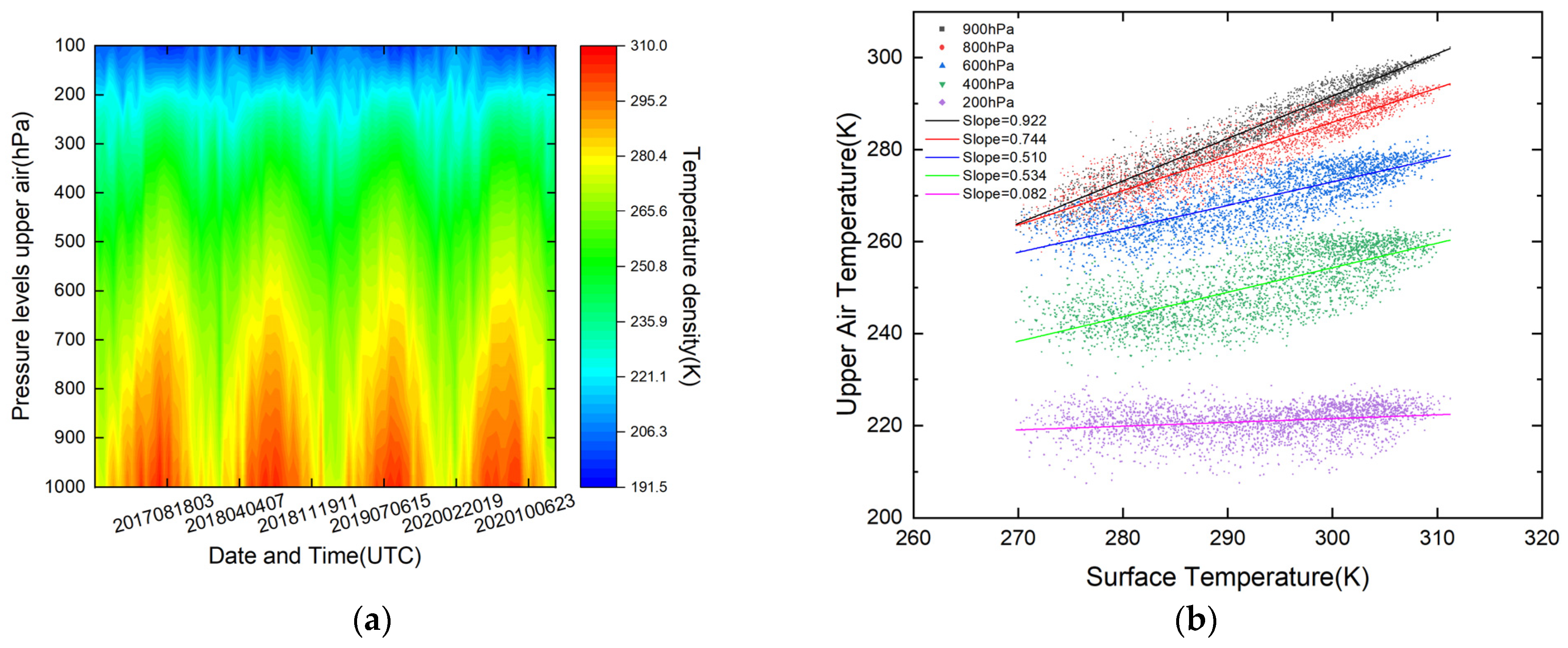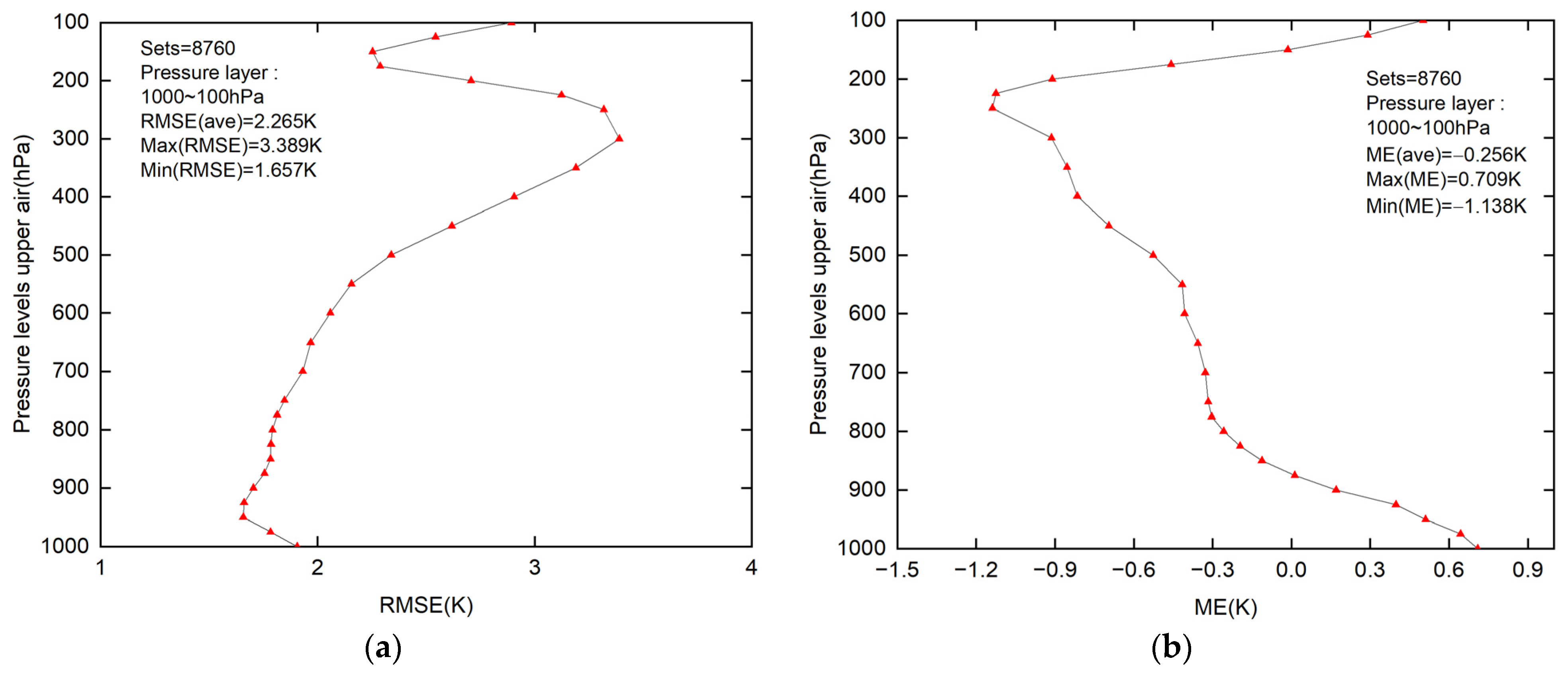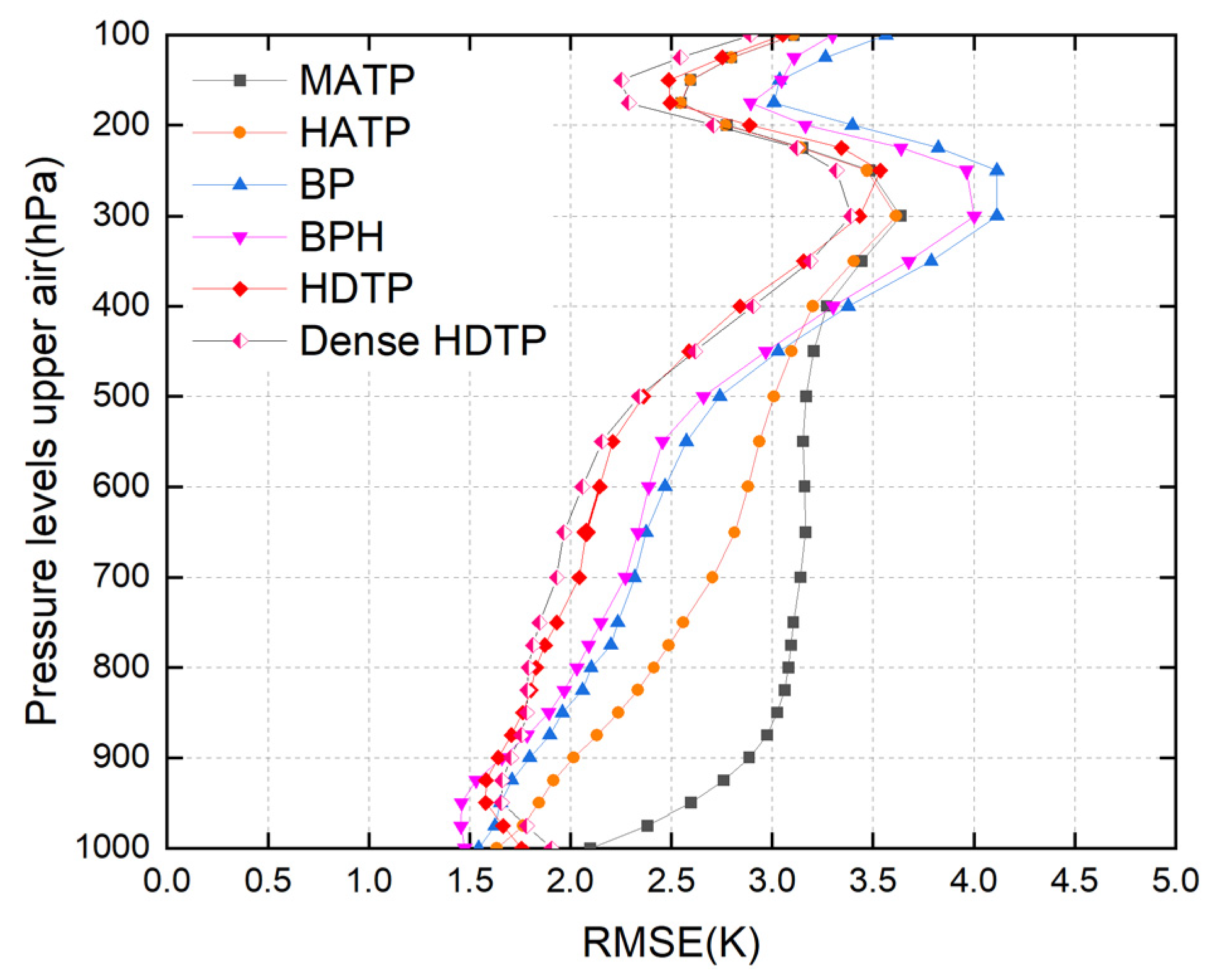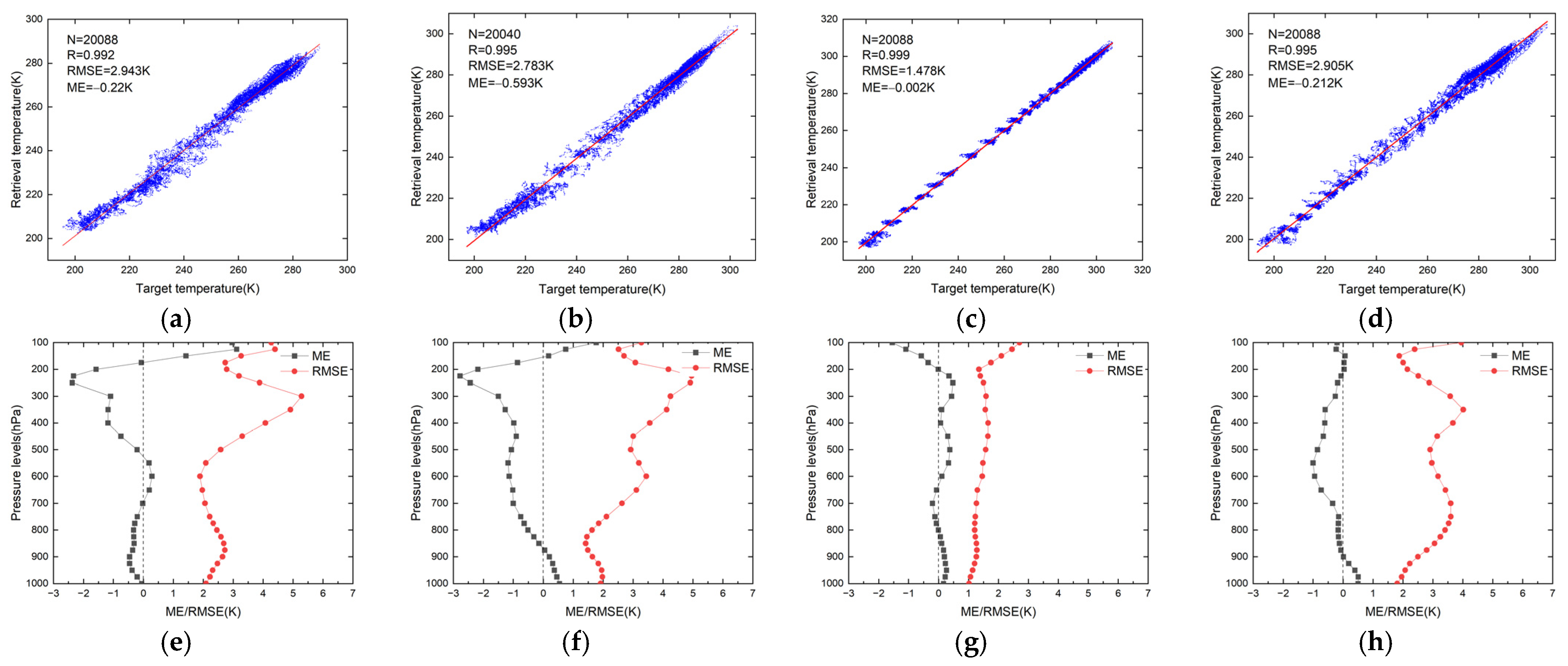1. Introduction
The atmospheric temperature profile which describes the distribution of temperature in the atmosphere with height is an essential parameter to describe the thermodynamic state of the atmosphere, and it is crucial to numerous practical and scientific applications, such as numeric weather prediction and climate studies [
1,
2,
3]. The accuracy of global temperature and humidity detection must reach the radiosonde level to fulfil the observational requirements of the World Meteorological Organization, which indicates that the profiles of tropospheric atmospheric temperature should be derived with a root-mean-square error (RMSE) of less than 1 °C and a final vertical resolution of 1 km [
4,
5]. Atmospheric profiles including atmospheric temperature profile are widely used in the research on radiative transfer models and atmospheric parameter retrieval [
6].
The widely applied atmospheric radiative transfer calculation models include LBLRTM [
7], FASCOD [
8], LOWTRAN [
9], and MODTRAN [
10,
11]. These calculation models require the input of atmospheric temperature profiles, which are typically represented by a subset of the 1966 Atmospheric Supplements (tropical [15N], middle latitude’ [45N] summer and winter, and subarctic [60N] summer and winter) and the U.S. Standard Model Atmosphere (1976) [
12]. Practical temperature profiles vary greatly with regions and seasons [
13], which means the spatiotemporal distribution is not fully represented by climatological temperature profiles. Errors may occur when climatological temperature profiles are used for model calculation and atmospheric parameter retrieval [
14]. Temperature profiles need to be in line with local conditions and must have real-time capability to perform well in atmospheric radiative transfer calculation.
Therefore, research on real-time temperature profile measurement and local atmospheric temperature profile models can support the application of atmosphere samples in studies on radiative transfer and remote sensing retrieval [
15]. The radiosonde is the traditional tool for measuring temperature profiles. By using radiosondes, meteorological departments can obtain the accurate distribution of atmospheric temperature and other profiles directly. However, problems still arise when radiosondes are employed to measure atmospheric temperature profiles. The results of radiosonde method are observed at certain geographical locations every 12 h. Radiosonde detection technology lacks temporal and spatial resolution and has significant disadvantages in terms of global coverage and continuous long-term measurement [
2,
16].
The extensive requirement on temperature information for continuous spatiotemporal observations of global and regional atmospheric features has made remote sensing an important measurement. Remote sensing facilitates the development of meteorological and atmospheric science research and applications [
17]. Remote sensing techniques for detecting tropospheric atmospheric temperature profiles can be divided into two types, namely, active and passive, depending on the detection mode. Each technique has its advantages in terms of vertical resolution and sensitivity to the boundary layer atmosphere [
18,
19]. The representative equipment of active remote sensing observations is lidar, which uses laser as the light source. Lidar studies the structure of the atmosphere by detecting the signal generated by the interaction between the laser and the target [
20]. It was widely used in the measurement of the spatial distribution and time evolution characteristics of atmospheric temperature. Lidar can detect atmospheric parameter profiles with high temporal and spatial resolutions compared with traditional radiosondes [
3,
21,
22]. The research on tropospheric atmospheric temperature focused on pure rotational Raman lidar. This type of lidar is designed to measure atmospheric temperature based on the dependence of the atmosphere molecular rotational Raman spectral envelope on temperature. Given the increasing research on atmospheric temperature detection, pure rotational Raman lidar became one of valid methods of profiling atmospheric temperature [
22,
23,
24]. The representative equipment of passive remote sensing observations are microwave radiometers and infrared hyperspectral sensors. Passive remote sensing refers to the technology or method wherein the remote sensing equipment receives electromagnetic radiation emitted by the atmosphere or reflects electromagnetic radiation from natural sources to obtain atmospheric information [
19]. Microwave radiometers receive atmospheric thermal radiation to retrieve the atmospheric temperature and humidity profile from multi-channel brightness temperature data [
19,
25]. Microwave radiometers have many advantages, such as simple operation, not being limited by airspace, and high time resolution. They became important instruments and are widely used in atmospheric profile remote sensing detection [
26,
27,
28]. Many studies [
28,
29,
30] showed that passive microwave data can be used to retrieve atmospheric temperature with strong validity. Infrared hyperspectral remote sensing detection retrieves the atmospheric temperature and humidity profile from CO
2 and H
2O absorption bands in infrared spectral bands [
18,
31,
32]. This method can obtain a highly detailed atmospheric structure and improve the ability and accuracy of detecting the atmosphere [
33,
34].
Studies [
18,
21,
25,
35,
36] showed that the main retrieval methods related to passive remote sensing can be divided into two types: statistical regression and physical methods. With the development of artificial intelligence technology, machine learning algorithms were gradually introduced into the field of atmospheric science [
33]. Studies [
34,
37,
38,
39] also showed that neural networks have better performance than traditional methods in the retrieval of temperature profiles. Remote sensing methods have their advantages and disadvantages. They all have high resolution and accuracy, but they are greatly influenced by high equipment costs. In practical applications, when remote sensing devices are unavailable, historical observations can be used to obtain atmospheric temperature profiles. A study [
40] reported that the addition of surface temperature factors helps improve the inversion results. Qin et al. (2003) [
41] proposed a model based on historical radiosonde and real-time ground data. The model combined the local month-by-month average temperature profile and the surface temperature to obtain the temperature profile at any moment through the interpolation of scale factors. However, only 12 monthly average temperature profiles can be obtained without considering the hourly temperature profile changes in a day. At the same time, the ground-based parameters only included the surface temperature and disregarded other parameters, such as atmospheric pressure, humidity, and total cloud cover.
To improve on the limitations of remote sensing, including limitations in the cost of building equipment, limitations in the spatial and temporal scope of measurements, and other disadvantages, a neural network that combines multi-layer perceptron (MLP) and convolutional neural network (CNN) is proposed to retrieve atmospheric temperature profiles. This study analyzes the time characteristics of the temperature profiles and potential information characterized by different ground-based parameters to improve the retrieval accuracy from historical and ground-based observations. This approach is also compared against several different model-based methods for retrieving atmospheric temperature profiles. The practical use of the proposed network construction method is demonstrated herein for retrieving temperature profiles in Fuyang city.
5. Conclusions
In this study, we proposed a method based on historical data and ground observation data to retrieve temperature profiles using neural networks. The neural network can learn the intrinsic relationship between input parameters and inversion parameters. Based on ERA-5 data, we established two machine learning models to invert the atmospheric temperature profile of Fuyang City. The first model directly inverted the atmospheric temperature profile from ground observation data, while the second model inverted the atmospheric temperature profile from ground observation data and historical temperature profile data of the same period. In order to optimize the performance of the model, we conducted experimental confirmation of the hyperparameters for the two models separately and obtained the best performing hyperparameters on the validation set. Finally, the model performed retrieval result verification on hourly temperature profile data for the whole year of 2021 and compared the results of the two models with those of other methods. The results showed that the inversion result of the second model was optimal, and the overall RMSE of the last 27 pressure levels reached 2.265 K.
In order to better evaluate the performance of the inversion model, this paper conducted an error analysis of the layer-by-layer distribution RMSE of the inversion results. Among them, the inversion error near the 300 hPa range was the largest. By analyzing the original data, it can be found that as the height increased, the correlation between high-altitude temperature and ground temperature gradually weakened, and the influence of ground factors on high-altitude temperature became smaller and smaller. Therefore, the result of inverting the temperature profile based on ground parameters was that as the height increased, the inversion error gradually increased. When it reached a height of 300 hPa, the correlation between high-altitude temperature and ground was weakest, and so, the inversion error at this height layer was the largest.
In addition, this paper used the inversion results of January, April, July, and October 2021 to represent the inversion performance of temperature profiles in spring, summer, autumn and winter, respectively. The results showed that the inversion result in July was the best with an RMSE of 1.478 K, while the inversion result in January was the worst with an RMSE of 2.934 K. Afterwards, we analyzed the reasons for the difference in inversion results by combining the distribution characteristics of atmospheric temperature profiles with the seasonal changes of the troposphere. This paper used the inversion results at 0:00 (UTC), 06:00 (UTC), 12:00 (UTC), and 18:00 (UTC) in July 2021 to evaluate the inversion performance of temperature profiles at different times. The results showed that the inversion result at 06:00 (UTC) was the best with an RMSE of 1.424 K, while the inversion result at 0:00 (UTC) was the worst with an RMSE of 1.505 K. Afterwards, we explained the error pattern of temperature profile inversion by combining the atmospheric structure and change rules of the boundary layer.
The proposed model achieved some success in the research of inverting atmospheric temperature profiles. Using the method proposed in this paper, it is easy to obtain data and it is simple in principle, but the current accuracy is not high enough and there is still a certain gap in the inversion accuracy of temperature profiles obtained by traditional detection and remote sensing methods. In the future, in order to improve the accuracy of temperature profile inversion using machine learning methods, we will consider adding more observation parameters to achieve the improvement of inversion accuracy.

